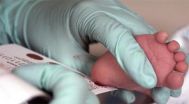(Press-News.org) COLUMBIA, Mo. — A new gene therapy developed by researchers at the University of Missouri School of Medicine has been shown to protect mice from a life-threatening heart condition caused by muscular dystrophy.
"This is a new therapeutic avenue," said Yi Lai, Ph.D., the leading author of the study and assistant research professor in the MU School of Medicine's Department of Molecular Microbiology and Immunology. "This is just a first step, but we hope this could lead to a treatment for people with this devastating heart condition, which is a leading cause of death for people with Duchenne muscular dystrophy."
About one in 3,500 children, mostly boys, are born with Duchenne muscular dystrophy (DMD). They experience a progressive wasting away of muscles, starting in the legs and pelvis. Children with DMD have difficulty walking, and most need wheelchairs by age 12.
As DMD depletes the skeletal muscles, it also causes the heart to decay. A weakened heart kills up to 40 percent of people with DMD, usually by their 20s or early 30s. DMD originates with mutations in a single gene. For more than two decades, researchers have explored using gene therapy, an experimental treatment, to replace the flawed gene with a healthy copy.
The recent MU study, however, did not try to replace the faulty gene. The researchers targeted a different gene — one involved with the heart's built-in system for responding to heart attacks and other emergencies.
This targeted gene expresses a protein called nNOS. During short-term stresses, nNOS activates briefly to help regulate the heart. The MU researchers altered the gene to enable more efficient transfer of the nNOS gene to mouse hearts.
Seven months after the gene therapy, the mice who received the treatment showed significantly improved overall heart health. On most disease indicators, the researchers found that the treatment protected their hearts from the damage of DMD.
"The study showed for the first time that a modified nNOS gene could be delivered through gene therapy to protect the hearts of mice from Duchenne muscular dystrophy," said Dongsheng Duan, Ph.D., co-author of the study and Margaret Proctor Mulligan Professor in Medical Research at the MU School of Medicine.
"Since nNOS protects against multiple heart diseases, this method could one day be extended to the treatment of other heart diseases, such as heart failure or a heart attack," Duan said.
The technique is in an early stage of development and will require more research before potential applications in humans are explored.
INFORMATION:
The study, "Partial Restoration of Cardiac Function with ∆PDZ nNOS in Aged MDX Model of Duchenne Cardiomyopathy," was published in Human Molecular Genetics. Along with Lai and Duan, other study authors include Junling Zhao, research technician, Yongping Yue, senior research specialist, and Nalinda B. Wasala, graduate student, all of the MU Department of Molecular Microbiology and Immunology.
TO DOWNLOAD BROADCAST-QUALITY VIDEO AND PHOTOS RELATED TO THIS STORY:
Please visit https://medicine.missouri.edu/ftp/.
User Name: ftpuser
Password: ftppass!
NOTE: Aaron Cooper, a journalism graduate student at MU, contributed to this story.
About the University of Missouri School of Medicine
The MU School of Medicine has improved health, education and research in Missouri and beyond for more than 165 years. MU physicians treat patients from every county in the state, and more Missouri physicians received their medical degrees from MU than from any other university. For more information, visit http://medicine.missouri.edu/.
Gene therapy protects mice from lethal heart condition, MU researchers find
The condition is a leading cause of death for those with Duchenne muscular dystrophy
2014-08-20
ELSE PRESS RELEASES FROM THIS DATE:
Providing futile care in the ICU prevents other patients from receiving critical care
2014-08-20
Providing futile treatment in the intensive care unit sets off a chain reaction that causes other ill patients needing medical attention to wait for critical care beds, according to a study by researchers from UCLA and RAND Health.
The study is the first to show that when unbeneficial medical care is provided, others who might be able to benefit from treatment are harmed, said study lead author Dr. Thanh Huynh, an assistant professor of medicine in the division of pulmonary and critical care medicine at the David Geffen School of Medicine at UCLA.
The findings also ...
Novel gene predicts both breast cancer relapse and response to chemotherapy
2014-08-20
Singapore—Scientists have made it easier to predict both breast cancer relapses and responses to chemotherapy, through the identification of a unique gene. The newly found marker could help doctors classify each breast cancer patient and customise a treatment regimen that is more effective. The discovery was a collaborative effort by scientists from A*STAR's Institute of Molecular and Cell Biology (IMCB), and the Cancer Science Institute of Singapore (CSI Singapore) at the National University of Singapore (NUS).
Despite advancements in cancer treatment, breast cancer ...
Record decline of ice sheets
2014-08-20
"The new elevation maps are snapshots of the current state of the ice sheets. The elevations are very accurate, to just a few metres in height, and cover close to 16 million km2 of the area of the ice sheets. This is 500,000 square kilometres more than any previous elevation model from altimetry", says lead-author Dr. Veit Helm, glaciologist at the Alfred Wegener Institute in Bremerhaven.
For the new digital maps, the AWI scientists had evaluated all data by the CryoSat-2 altimeter SIRAL. Satellite altimeter measure the height of an ice sheet by sending radar or laser ...
Researchers find security flaws in backscatter X-ray scanners
2014-08-20
A team of researchers from the University of California, San Diego, the University of Michigan, and Johns Hopkins University have discovered several security vulnerabilities in full-body backscatter X-ray scanners deployed to U.S. airports between 2009 and 2013.
In laboratory tests, the team was able to successfully conceal firearms and plastic explosive simulants from the Rapiscan Secure 1000 scanner. The team was also able to modify the scanner operating software so it presents an "all-clear" image to the operator even when contraband was detected. "Frankly, we were ...
Testing the shelf-life of nuclear reactors
2014-08-20
Oxford, August 20, 2014 – Researchers at the University of Michigan, Ann Arbor, Los Alamos National Laboratory, Idaho National Laboratory, Idaho Falls and TerraPower based in Bellevue, Washington, have demonstrated the power of high-energy beams of charged particles (ions). The ions can rapidly and consistently damage samples of ferritic-martensitic steel, the material used in certain nuclear reactor components. The significance of the result is that the breakdown closely replicates that seen when high-energy neutrons from a nuclear reactor interact with the material - ...
Chemically extracted acellular allogeneic nerve graft with CNTF for sciatic nerve repair
2014-08-20
Chemically extracted acellular allogeneic nerve, from which Schwann cells, myelin sheath and disintegrating fragments have been removed, reduced postoperative immune rejection. Simultaneously, chemically extracted acellular allogeneic nerve retains neural substrates and base materials, such as the bottom layer of Schwann cells, which can provide a good scaffold in the process of nerve regeneration. Chemically extracted acellular allogeneic nerve, similar to autologous nerve transplantation, can guide nerve regeneration and provide a favorable local environment for neural ...
The channel that relaxes DNA
2014-08-20
VIDEO:
This is a model DNA chain inside a nanochannel that is 100nm wide.
The spontaneous dynamical evolution of the DNA is accompanied by frequent knotting and entanglement at the chain ends....
Click here for more information.
With the widespread use of methods for DNA analysis and manipulation, it's certainly useful to find a way to unravel and relax the strands of this molecule that tends to form tangles spontaneously. One way is to use channels, or rather nano-channels, ...
Test reliably detects inherited immune deficiency in newborns
2014-08-20
A newborn screening test for severe combined immunodeficiency (SCID) reliably identifies infants with this life-threatening inherited condition, leading to prompt treatment and high survival rates, according to a study supported by the National Institutes of Health. Researchers led by Jennifer Puck, M.D., of the University of California, San Francisco, also found that SCID affects approximately 1 in 58,000 newborns, indicating that the disorder is less rare than previously thought. The study was funded in part by NIH's National Institute of Allergy and Infectious Diseases ...
Mums trust mums on the net: Australian study
2014-08-20
Facebook groups for mothers are overtaking the traditional mums-and-bubs and playgroup environments as a source of trusted advice, and offers a largely untapped marketing tool for businesses wanting to sell their products, an Australian study has found.
QUT educationalist Dr Rebecca English and marketing expert Dr Raechel Johns from the University of Canberra said word-of-mouth in mothers' groups and communities had fast become a major influence in mothers' buying habits.
The study, Mothers' influencing mothers: the use of virtual discussion boards and their influence ...
Sunblock poses potential hazard to sea life
2014-08-20
The sweet and salty aroma of sunscreen and seawater signals a relaxing trip to the shore. But scientists are now reporting that the idyllic beach vacation comes with an environmental hitch. When certain sunblock ingredients wash off skin and into the sea, they can become toxic to some of the ocean's tiniest inhabitants, which are the main course for many other marine animals. Their study appears in the ACS journal Environmental Science & Technology.
Antonio Tovar-Sanchez and David Sánchez-Quiles point out that other than staying indoors, slathering on sunscreen is currently ...
LAST 30 PRESS RELEASES:
Researchers uncover axonal protein synthesis defect in ALS
Why are men more likely to develop multiple myeloma than women?
Smartphone-based interventions show promise for reducing alcohol and cannabis use: New research
How do health care professionals determine eligibility for MAiD?
Microplastics detected in rural woodland
JULAC and Taylor & Francis sign open access agreement to boost the impact of Hong Kong research
Protecting older male athletes’ heart health
KAIST proposes AI-driven strategy to solve long-standing mystery of gene function
Eye for trouble: Automated counting for chromosome issues under the microscope
The vast majority of US rivers lack any protections from human activities, new research finds
Ultrasound-responsive in situ antigen "nanocatchers" open a new paradigm for personalized tumor immunotherapy
Environmental “superbugs” in our rivers and soils: new one health review warns of growing antimicrobial resistance crisis
Triple threat in greenhouse farming: how heavy metals, microplastics, and antibiotic resistance genes unite to challenge sustainable food production
Earthworms turn manure into a powerful tool against antibiotic resistance
AI turns water into an early warning network for hidden biological pollutants
Hidden hotspots on “green” plastics: biodegradable and conventional plastics shape very different antibiotic resistance risks in river microbiomes
Engineered biochar enzyme system clears toxic phenolic acids and restores pepper seed germination in continuous cropping soils
Retail therapy fail? Online shopping linked to stress, says study
How well-meaning allies can increase stress for marginalized people
Commercially viable biomanufacturing: designer yeast turns sugar into lucrative chemical 3-HP
Control valve discovered in gut’s plumbing system
George Mason University leads phase 2 clinical trial for pill to help maintain weight loss after GLP-1s
Hop to it: research from Shedd Aquarium tracks conch movement to set new conservation guidance
Weight loss drugs and bariatric surgery improve the body’s fat ‘balance:’ study
The Age of Fishes began with mass death
TB harnesses part of immune defense system to cause infection
Important new source of oxidation in the atmosphere found
A tug-of-war explains a decades-old question about how bacteria swim
Strengthened immune defense against cancer
Engineering the development of the pancreas
[Press-News.org] Gene therapy protects mice from lethal heart condition, MU researchers findThe condition is a leading cause of death for those with Duchenne muscular dystrophy






